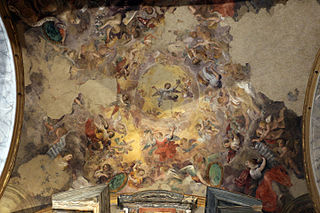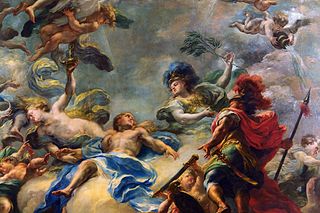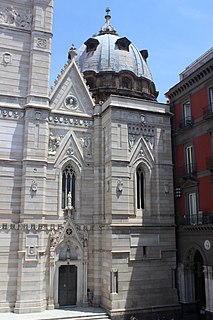Related Research Articles

Luca Giordano was an Italian late-Baroque painter and printmaker in etching. Fluent and decorative, he worked successfully in Naples and Rome, Florence, and Venice, before spending a decade in Spain.

Sebastiano Conca was an Italian painter.

Belisario Corenzio was a Greek-Italian painter, active in Venice and Naples. He is one of few Greek painters that did not belong to the Cretan Renaissance like his contemporaries of the time. He escaped the maniera greca completely. He adopted the Venetian style. Other similar Greek painters were Marco Basaiti, Ioannis Permeniates, Antonio Vassilacchi and El Greco. He was sometimes referred to as Il Greco. His teacher was prominent Venetian painter Tintoretto. In 1590, at age 32 Corenzio settled in Naples. Corenzio was influenced by Cavalier d'Arpino. He continued to flourish in the region. His apprentices included: Luigi Rodriguez, Andrea di Leone, Onofrio De Lione and Massimo Stanzione. Corenzio painted many frescos that survived today. Some of his works are in the Church of San Severino and Certosa di San Martino. His style resembles Caravaggio. An Italian legend in Naples exists involving Corenzio, Spanish painter Jusepe de Ribera, and Battistello Caracciolo. They were referred to as the Cabal of Naples. The three painters were rumored to have poisoned their competition for painting contracts. The rumors lack documented evidence. The three painters were very popular in Naples. Corenzio frescoed the Crypt that holds the remains of Matthew the Apostle at Salerno Cathedral and it depicts scenes from the Gospel of Matthew. Corenzio was one of the most celebrated fresco painters in Naples during his time. His drawings can be found all over the world namely at the Metropolitan Museum, Museo di Capodimonte and Louvre.

Francesco Vanni was an Italian painter, draughtsman, printmaker, publisher and printer active in Rome and his native city of Siena.

Domenico Morelli was an Italian painter, who mainly produced historical and religious works. Morelli was immensely influential in the arts of the second half of the 19th century, both as director of the Accademia di Belle Arti in Naples, but also because of his rebelliousness against institutions: traits that flourished into the passionate, often patriotic, Romantic and later Symbolist subjects of his canvases. Morelli was the teacher of Vincenzo Petrocelli.

Marcello Venusti was an Italian Mannerist painter active in Rome in the mid-16th century.

Paolo de Matteis was an Italian painter.

Giovanni Bernardino Azzolini was an Italian painter and sculptor who continued painting in a late-Mannerist style, mainly active in Naples and Genoa. He is also known by Azzolino or Mazzolini or Asoleni.

Luigi Garzi was an Italian painter of the Baroque period, whose work displayed heavy influences of the Bolognese painter, Guido Reni.

Ippolito Borghese was an Italian painter of the late-Renaissance, born in Sigillo.
Bernardo Tesauro (1440–1500) was an Italian painter of the Renaissance period. He was born in Naples. He was a relative of Filippo Tesauro. He was a pupil of Silvestre dei Buoni. He painted an Assumption of the Virgin for the church of San Giovanni Maggiore in Naples.

Francesco Allegrini da Gubbio (1587–1663) was an Italian painter of the Baroque period. His children, Flaminio and Angelica Allegrini, were also painters. Angelica painted a canvas for the church of San Francesco, Gubbio.

Paolo Domenico Finoglia, or Finoglio, was an Italian painter of the early-Baroque period, active mainly in South Italy, including Naples and towns in Apulia.
Giovanni Battista Buonocore was an Italian painter of the Baroque period. He became Rector (1679), then Principe (1698) of the Accademia di San Luca of Rome.
Pompeo Landulfo was an Italian painter active mainly in Naples. He was born in Maddaloni near Caserta, Italy.

Giacomo del Pò, also spelled del Po, was an Italian painter of the Baroque. He was born in Palermo, the son of Pietro del Pò who was also his teacher.

The Royal Chapel of the Treasure of St. Januarius, or the Reale cappella del Tesoro di San Gennaro, is a chapel located in the Cathedral of Naples, Italy, and dedicated to St. Januarius, patron saint of the city. This is the most lavishly decorated chapel in the Cathedral, and contains contributions by the premier Baroque artists in Naples.
Carlo Rosa 1613 – September 12, 1678) was an Italian painter.

Dirck Hendricksz was a Dutch-Italian painter. In Italy he was known as Teodoro d'Errico or Dirk Hendrici. He was engaged in painting mainly altarpieces and for churches in Naples from 1574-1606. Although born in Holland, he is referred in texts as a Flemish painter.
Niccolò di Tommaso was an Italian painter active in Florence, Naples and Pistoia.
References
- Bryan, Michael (1886). Robert Edmund Graves (ed.). Dictionary of Painters and Engravers, Biographical and Critical. Vol. I: A-K. London: George Bell and Sons. p. 229.